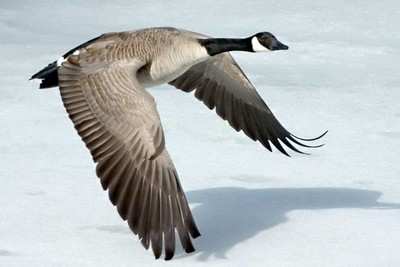Fri, Feb 13, 2009
Adult Birds Often Exceed Engine Ingestion Weight Standard
The National Transportation Safety Board confirmed Thursday the
bird remains found in both engines of
US Airways flight 1549 have been identified by
the Smithsonian Institution's Feather Identification Laboratory as
Canada Goose (Branta canadensis).

The lab made the identification for the NTSB through DNA
analysis as well as through morphological comparisons in which
feather fragments were compared with Canada Goose specimens in the
museum's collections; the microscopic feather samples were compared
with reference microslide collections.
A total of 25 samples of bird remains have been examined as of
Thursday. Additional analysis will be conducted on samples received
from the NTSB to attempt to determine if the Canada Geese were
resident or migratory.
While no determination has been made about how many birds the
aircraft struck or how many were ingested into the engines, an
adult Canada Goose typically ranges in size from 5.8 to 10.7
pounds, though larger individual resident birds can exceed
published records.
The accident aircraft was powered by two CFM56-5B/P turbofan
engines. The bird ingestion standard in effect when this engine
type was certified in 1996 included the requirement that the engine
must withstand the ingestion of a four-pound bird without catching
fire, without releasing hazardous fragments through the engine
case, without generating loads high enough to potentially
compromise aircraft structural components, or without losing the
capability of being shut down. The certification standard does not
require that the engine be able to continue to generate thrust
after ingesting a bird four pounds or larger.

NTSB investigators worked closely with wildlife biologists from
the United States Department of Agriculture, both at the scene of
the accident in New York City and during the engine teardowns at
the manufacturer's facility in Cincinnati, to extract all of the
organic material that was identified.
(Goose photo by Chuck Szmurlo)
More News
Airport Marking Aids Markings used on runway and taxiway surfaces to identify a specific runway, a runway threshold, a centerline, a hold line, etc. A runway should be marked in ac>[...]
"It is extremely difficult, if not impossible, for manned aircraft to see a drone while conducting crop-enhancing and other aerial applications at low altitudes and high speeds. We>[...]
Aero Linx: The Skyhawk Association The Skyhawk Association is a non-profit organization founded by former Skyhawk Pilots which is open to anyone with an affinity for the A-4 Skyhaw>[...]
“The T-54A benefits from an active Beechcraft King Air assembly line in Wichita, Kansas, where all required METS avionics and interior modifications are installed on the line>[...]
Aero Linx: Aerostar Owners Association The Association offers the Aerostar Owner a unique opportunity to tap an invaluable source of information concerning the care and feeding of >[...]
 ANN's Daily Aero-Term (04.28.24): Airport Marking Aids
ANN's Daily Aero-Term (04.28.24): Airport Marking Aids Aero-News: Quote of the Day (04.28.24)
Aero-News: Quote of the Day (04.28.24) ANN's Daily Aero-Linx (04.28.24)
ANN's Daily Aero-Linx (04.28.24) Aero-News: Quote of the Day (04.29.24)
Aero-News: Quote of the Day (04.29.24) ANN's Daily Aero-Linx (04.29.24)
ANN's Daily Aero-Linx (04.29.24)




